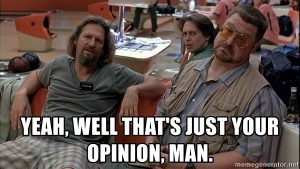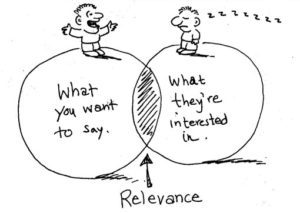So You Can Coach, But Can You Present?
 by Jenny Dziubla
by Jenny Dziubla
It is now a widely accepted practice to incorporate breath training into exercise. This hasn’t always been the case. For a long time, we assumed that our ability to breathe without conscious awareness meant we were doing it effectively. But as this Movement As Medicine article states;
Unfortunately, lack of consciousness for our breathing patterns can also lead us into trouble. Somewhere along the way in the everyday shuffle, many people will develop postural faults that will lead to inefficient breathing.”
The same is true for communication.
On average, you spend 70-80% of your waking hours in some form of communication. As with breathing, it’s something you often do without conscious awareness. But as has been shown about breathing, just because you have the ability to communicate doesn’t mean you’re doing it effectively. And more likely than not, the habits you’ve picked up along the way are directly impacting the effectiveness of your communication and ability to grow in your career.
Of all the money that is spent on formal education and continuing education, not enough is spent on learning how to have ‘presence’, formulate and structure ideas, and then effectively share those ideas with others – or more simply stated, how to present.
All fitness professionals are in the customer service business. Your success and reputation are highly dependent on what other people think about you. But how do people formulate those opinions? It’s what they initially see and hear (their first impression), the quality of your ongoing interactions, and finally the credibility and organization of the information you share with them.
Of all of these, the most important is the first impression. In his book Blink, Malcolm Gladwell explains how we use the adaptive unconscious part of our brain. He says, “We thin-slice whenever we meet a new person or have to make sense of something quickly or encounter a novel situation. We thin-slice because we have to, and we come to rely on that ability because there are lots of situations where careful attention to the details of a very thin slice, even for no more than a second or two, can tell us an awful lot.” This is why your initial physical and vocal presence when meeting someone new is so important. If people are making judgments about you in the first one to two minutes, you need to come across as professional, confident, and knowledgeable.
Ask any fitness professional how often they ‘present’ to an audience and most will respond by saying not very often or rarely. This is not true. In fact, you’re presenting to an audience every single day. You’re presenting to an audience when you pick up the phone, when you meet with a new client, when you interact with an existing client, when you informally share your ideas at a staff meeting when you interact with your co-workers and superiors, and so on. These seemingly unimportant (but frequent) interactions are the building blocks that make up your reputation and can lead to professional success.
“Success is doing ordinary things extraordinarily well.” – Jim Rohn
Take a moment to reflect on just one interaction you’ve had in your professional career that didn’t go well. Maybe you weren’t giving a conversation with a new client your full attention, maybe you didn’t prepare in advance for an important meeting and couldn’t clearly convey your ideas, or maybe you posted something online without adequate review or objective feedback first. Now imagine if that interaction had gone well. It was a missed opportunity. One that could have led you down an entirely different path. Now multiply that across the length of your career. It’s important to recognize that opportunity surrounds you every day, and it’s your responsibility to recognize and take full advantage by knowing how to present yourself and show up when it matters most.
If I’ve convinced you of the importance of presentation skills as a fitness professional, check out what I call The Big 3 below. They’re three easy-to-implement tips that will have a dramatic impact on your presence and the quality of your interactions.
1). Make Purposeful Eye Contact
When it comes to presenting, sustained and intentional eye contact with one person at a time is the easiest way to engage your audience. Purposeful eye contact also helps manage several other areas…
- Your ability to concentrate on what you want to say. Why? Because you’re not taking in additional stimuli by ‘scanning’ the room which can break your focus while speaking.
- Your impression on the audience. When you don’t make eye contact, you come across as lacking both confidence and authority.
- Your Pace. When you speak one thought to one person, then pause in silence while you find a new set of eyes to engage with, you’re building in natural pauses to your speech. It’s not that we speak too quickly, it’s that there are no pauses in that rate of speech.
One caveat is don’t stare. Keep eye contact with someone for one thought or one brief sentence, then move on to a new person. Pay attention to social cues. The person you’re looking at will make it obvious when you’ve made it creepy.
2). Have Evidence; Not Just Opinions

If you’re proposing a new idea or recommending that someone or a group of people change something, your opinions hold little to no value. To be credible and convincing you must have supporting evidence. Evidence gives an objective foundation to your arguments. This evidence can come in the form of research studies, statistics and facts, video examples, demonstrations, personal experiences (such as with athletes or clients you work with regularly), other’s experiences, analogies, quotes, and so on. It’s evidence that makes your presentation persuasive and memorable, not your personal opinions.
“What can be asserted without evidence can be dismissed without evidence.” – Christopher Hitchens
But be sure to give credit where credit is due. When using information outside of your personal opinions and experiences, be sure you reference where the information came from and don’t claim it as your own. Give others the credit they deserve for doing the work you’re now benefiting from.
3). Know Who You Are Talking To

It’s your responsibility as a presenter to be sure the information you’re sharing can be understood by the specific audience you’re speaking to. If you’re presenting to a group of high school athletes, you don’t want to talk about heart rate variability training or the intricacies of anatomy. This seems obvious but think about how many presentations you’ve sat through where the presenter used terms or shared information that was above your base of knowledge. Not only is it frustrating to the audience, but it also gives them a reason to tune out.
Why is this so hard for some of us to simplify our ideas and information? Because we’ve been cursed with knowledge! As this Harvard Business Review article states, “The problem is that once we know something—say, the melody of a song—we find it hard to imagine not knowing it. Our knowledge has “cursed” us. We have difficulty sharing it with others because we can’t readily re-create their state of mind.”
Whether you’re presenting one-on-one or to a group, ask these questions before you decide what you’ll say:
- Who is my audience – group of clients, other trainers, industry experts, prospective clients?
- Why are they listening to me – because of my topic, because they’re attending an industry event, because their boss told them they should because they’re a paying client?
- How much do they know about my information – have they had any exposure to my topic? If so, how much and from what sources?
- Do they already have viewpoints or opinions about my topic – what are they? Are they supportive or skeptical?
- How do they learn – are they used to learning visually, aurally, or physically? What’s their attention span?
The Big 3 are a great starting point if you’re new to presenting. At the very least, they’ll bring awareness to some of your existing strengths and shortcomings. However, if you’re someone who presents on a regular basis and has never had formal presentation skills training, hire a coach. As with any new skillset we want to learn, we need to expose ourselves to objective review, coaching, and active practice.
If you take just one thing from this article, let it be this:
YOU are your product. Your knowledge and experience are just ‘features’ of that product. You can have big ideas, but if you cannot communicate those to your clients, peers, and others in your network with poise, clarity, and in a simple-to-follow manner, your ideas will take you nowhere. Go the extra mile. Invest in your presentation skills. Learn a skillset that could forever change the course of your career.
“There are no traffic jams along the extra mile.” – Roger Staubach (NFL Hall of Famer)
Vautier Communications offers individual presentation coaching as well as a 2-day Presentation Skills program. In the program, you’ll learn a set of skills to own the front of a room, how to create and organize more effective presentations, and how to apply these things across a range of presentation options.
2019 Program Dates
- Chicago 2019: Feb. 20 – 21, Apr. 3 – 4, June 5 – 6, Aug. 21 – 22, Oct. 9 – 10, Dec. 4 – 5
- San Diego: Feb. 13 – 14, May 1 – 2, Aug. 7 – 8, Oct. 2 – 3
- Bay Area: Mar. 6 – 7, July 17 – 18
- Sacramento: May 15 – 16, Sep. 18 – 19
Jenny Dziubla is a Communications Coach with Vautier Communications and moonlights as a trainer for both individuals and groups. She is a Certified Functional Strength Coach and is based in San Jose, CA. Email Jennyd@vautiercommunications.com for individual presentation coaching or program registration information.